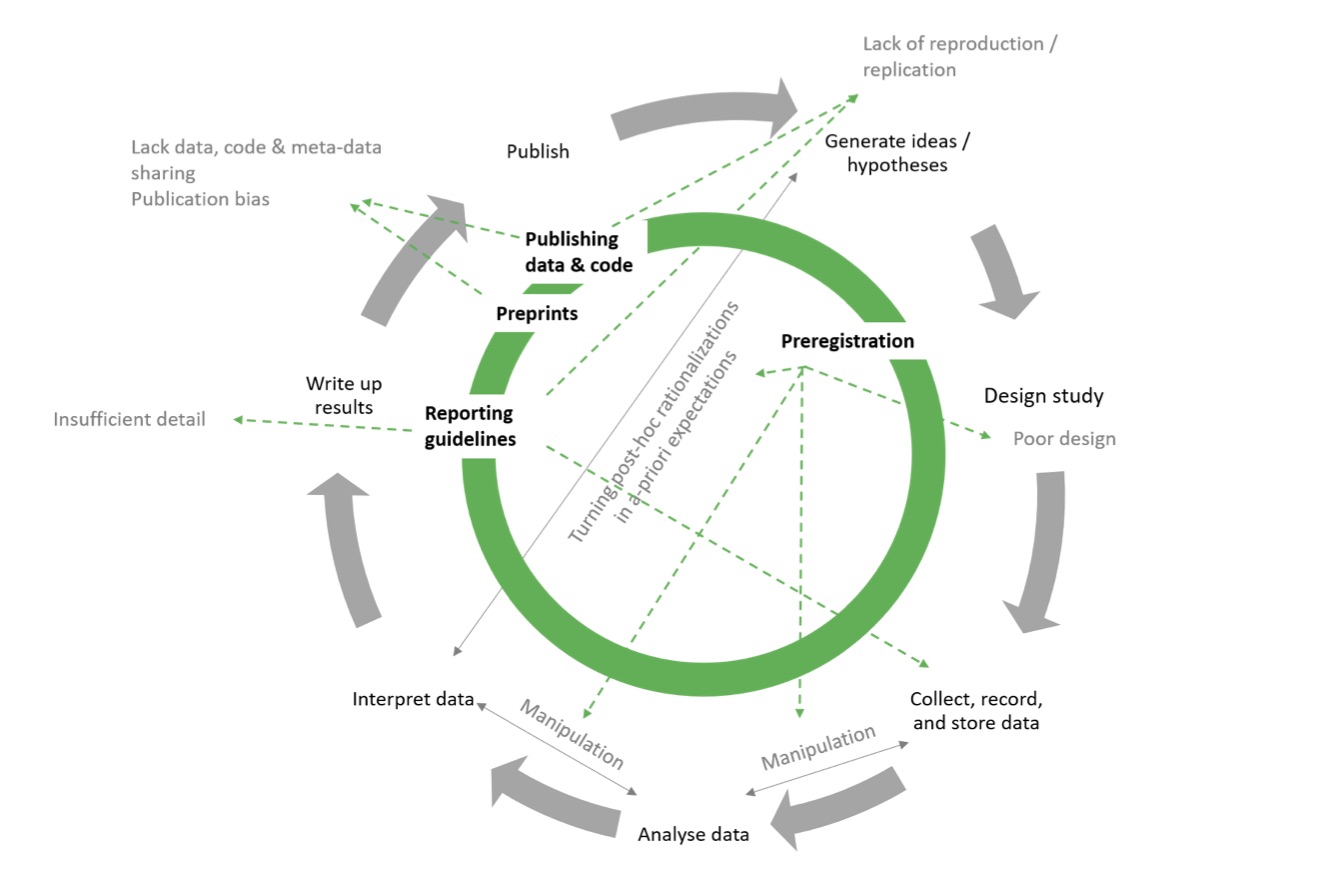
www.buildingsandcities.org/insights/news/quality-energy-research-practices.html
Improving Energy Research Practices
How can energy
research practices be improved? A new approach emphasizing transparency, reproducibility
and quality in a recently published Buildings & Cities peer-reviewed article explains what energy researchers can do to improve their research design, execution and
writing.
A recent peer-reviewed Methods paper, published in Buildings & Cities, explores how practices could be improved in the conduct and publishing of energy research. Huebner, Fell & Watson (2021) highlight the importance of good quality research for applied energy studies, which often inform policy and can be of direct relevance in determining appropriate action for tackling and adapting to climate change. Given the urgency and gravity of this task, they argue that the rigour and quality of energy research should be subject to publishing practices similar to those used in the psychological and medical sciences. This is crucial reading for researchers beginning their careers, those already established, but also research councils and funders. In particular, these readers can gain insight into how to conduct and assess high quality research, and identify resources to support with the planning and implementation of a range of research approaches.
The authors focus on three dimensions of
'good research': transparency, reproducibility and quality and provide a clear
process for thinking about how to implement this into research practices. In
the paper, transparency is taken to mean making the essential components of
research (for example, sampling and analytical approaches) visible to others.
Reproducibility considers how information can be provided such that independent
studies can seek to reproduce results. The authors' preferred definition of
quality is less clear, but the implication is that this includes research which
'poses important questions, uses appropriate methods, assesses bias, and
considers alternative explanations for findings' (p. 3; following a definition
from the National Center for Dissemination of Disability).
Drawing on ideas and practices adapted from other scientific fields, particularly medicine and psychology, four specific tools are introduced for achieving transparency, reproducibility and quality:
- preregistration of analysis plans (pre-analysis plans)
- making data and code publicly available
- using preprints
- employing reporting guidelines
Pre-analysis plans specify the study aims, types of data collection, and data analysis approach. The authors highlight the value of these for preventing the manipulation of research data to present favourable results. Reporting guidelines provide a means to support authors in determining what information to include in papers, for example sampling methods and recruitment processes. The authors suggest that preprints can be helpful for overcoming publishing bias (for example, where journals give preference to studies which demonstrate significant findings). Finally, the authors advocate for open data, or placing available data in an online repository. They highlight research which finds that research using open source data and code receives more citations than those publishing from closed data. A useful mantra, highlighted in the paper, is the European Commission's (2016) principle that research data should be 'as open as possible, as closed as necessary'.
The authors acknowledge that these different tools have varied degrees
of relevance for distinct approaches. For example, exploratory research (where
a strategy for analysis is not pre-determined) may be less amenable to a
pre-analysis plan. However, with hyperlinks to pre-analysis plans and reporting
guidelines for a variety of research approaches (including both qualitative and
quantitative strategies), the article is itself a useful repository to work
from when planning and publishing research. In addition, adopting these
approaches will help to align energy research with accepted best practice in
fields with rigorous checks on research quality, such as medicine.

Source: Huebner, Fell & Watson (2021)
The authors emphasise the need for 'more structural adjustments to the energy research ecosystem' (p.14). In particular, they highlight that some poor research and publishing practices are reinforced by the expectations of journals, for example prioritising the publication of research with significant results or confirming hypotheses, rather than research with 'negative' results.
Diverging from this norm, Buildings
& Cities welcomes Methods articles (like that discussed here) which
outline new techniques and critique existing approaches, and Replication
articles which explicitly set out to test previous findings, validate existing
data, and report results demonstrating 'failure'. With this Methods article,
Huebner, Fell & Watson have opened up dialogue around research quality, and
how tools used in the publishing process can create reassurances around this.
The next task is to work out how to continue this debate such that the broad
gamut of energy researchers can coalesce around a mutually agreed set of
guidance.
Latest Peer-Reviewed Journal Content
Designing for pro-environmental behaviour change: the aspiration–reality gap
J Simpson & J Uttley
Lifetimes of demolished buildings in US and European cities
J Berglund-Brown, I Dobie, J Hewitt, C De Wolf & J Ochsendorf
Expanding the framework of urban living labs using grassroots methods
T Ahmed, I Delsante & L Migliavacca
Youth engagement in urban living labs: tools, methods and pedagogies
N Charalambous, C Panayi, C Mady, T Augustinčić & D Berc
Co-creating urban transformation: a stakeholder analysis for Germany’s heat transition
P Heger, C Bieber, M Hendawy & A Shooshtari
Placemaking living lab: creating resilient social and spatial infrastructures
M Dodd, N Madabhushi & R Lees
Church pipe organs: historical tuning records as indoor environmental evidence
B Bingley, A Knight & Y Xing
A framework for 1.5°C-aligned GHG budgets in architecture
G Betti, I Spaar, D Bachmann, A Jerosch-Herold, E Kühner, R Yang, K Avhad & S Sinning
Net zero retrofit of the building stock [editorial]
D Godoy-Shimizu & P Steadman
Co-learning in living labs: nurturing civic agency and resilience
A Belfield
The importance of multi-roles and code-switching in living labs
H Noller & A Tarik
Researchers’ shifting roles in living labs for knowledge co-production
C-C Dobre & G Faldi
Increasing civic resilience in urban living labs: city authorities’ roles
E Alatalo, M Laine & M Kyrönviita
Co-curation as civic practice in community engagement
Z Li, M Sunikka-Blank, R Purohit & F Samuel
Preserving buildings: emission reductions from circular economy strategies in Austria
N Alaux, V Kulmer, J Vogel & A Passer
Urban living labs: relationality between institutions and local circularity
P Palo, M Adelfio, J Lundin & E Brandão
Living labs: epistemic modelling, temporariness and land value
J Clossick, T Khonsari & U Steven
Co-creating interventions to prevent mosquito-borne disease transmission in hospitals
O Sloan Wood, E Lupenza, D M Agnello, J B Knudsen, M Msellem, K L Schiøler & F Saleh
Circularity at the neighbourhood scale: co-creative living lab lessons
J Honsa, A Versele, T Van de Kerckhove & C Piccardo
Positive energy districts and energy communities: how living labs create value
E Malakhatka, O Shafqat, A Sandoff & L Thuvander
Built environment governance and professionalism: the end of laissez-faire (again)
S Foxell
Co-creating justice in housing energy transitions through energy living labs
D Ricci, C Leiwakabessy, S van Wieringen, P de Koning & T Konstantinou
HVAC characterisation of existing Canadian buildings for decarbonisation retrofit identification
J Adebisi & J J McArthur
Simulation and the building performance gap [editorial]
M Donn
Developing criteria for effective building-sector commitments in nationally determined contributions
P Graham, K McFarlane & M Taheri
Join Our Community

The most important part of any journal is our people – readers, authors, reviewers, editorial board members and editors. You are cordially invited to join our community by joining our mailing list. We send out occasional emails about the journal – calls for papers, special issues, events and more.
We will not share your email with third parties. Read more



Latest Commentaries
COP30 Report
Matti Kuittinen (Aalto University) reflects on his experience of attending the 2025 UN Conference of the Parties in Belém, Brazil. The roadmaps and commitments failed to deliver the objectives of the 2025 Paris Agreement. However, 2 countries - Japan and Senegal - announced they are creating roadmaps to decarbonise their buildings. An international group of government ministers put housing on the agenda - specifying the need for reduced carbon and energy use along with affordability, quality and climate resilience.
Building-Related Research: New Context, New Challenges
Raymond J. Cole (University of British Columbia) reflects on the key challenges raised in the 34 commissioned essays for Buildings & Cities 5th anniversary. Not only are key research issues identified, but the consequences of changing contexts for conducting research and tailoring its influence on society are highlighted as key areas of action.